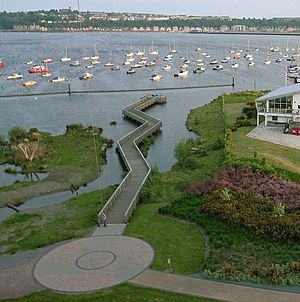Cardiff Bay Wetlands Reserve facts for kids
The Cardiff Bay Wetlands Reserve is a special place for wildlife in Cardiff Bay, Cardiff. It covers about 8 hectares (nearly 20 acres) of land and water. This area officially opened as a wildlife reserve on July 25, 2002. Before that, it was a salty marsh. But after the Cardiff Bay Barrage was built in April 2001, the area became a large freshwater lake, and the reserve was created from it.
Contents
How the Wetlands Were Built

The Cardiff Harbour Authority, which looks after Cardiff Bay, chose this spot to create a new home for wildlife. They wanted to make up for the loss of the old mudflats in Cardiff Bay.
Building the reserve was a big project. A landscape architect named Phil Williams helped design it. He explained that it was tricky because they didn't know exactly how the water levels might change. This meant they had to be careful to make sure new plants and animals could live there.
After the reserve was built, lots of rubbish flowed down the River Taff and gathered nearby. So, in 2003, the Cardiff Harbour Authority put up a long floating barrier, called a boom. This boom stops the rubbish from getting into the reserve and harming the wildlife.
Exploring the Wetlands Reserve
Wetlands are amazing places where water meets land. They are super important homes for many different kinds of birds, fish, and plants.
You can find the Cardiff Bay Wetlands Reserve close to St David's Hotel and near Mermaid Quay.
Before the Cardiff Bay Barrage was built, this area was mostly mudflats and salty marshes. Now, the wetlands reserve is a freshwater habitat.
This reserve is a real hot-spot for biodiversity in Cardiff Bay. It has lots of reedbeds and other water plants. These plants are very important for many creatures.
- Many birds like reed buntings, reed warblers, and sedge warblers build their nests here.
- Reedbeds are also vital for insects, fish, and amphibians.
You can see interesting birds and wildlife here all year round. In spring, you might hear birds singing as they breed. In autumn and winter, you might spot visitors like teal and stonechat.
The Wetlands Food Web
The animals and plants in the Cardiff Bay Wetlands are all connected in a food web. This means they depend on each other for food.
- Tiny creatures like midge larvae and worms live in the mud.
- Birds like snipe eat these small creatures.
- Insects like dragonflies live in the water as babies and then fly around as adults. You might even see black-tailed skimmers hunting!
- Some insects, like Cinnabar moth caterpillars, eat specific plants such as ragwort.
Fish also live in the shallow parts of the reserve. The warm water and many plants make it a great place for small fish to grow. It gives them food and places to hide.
Some birds spend a lot of time here because they can catch fish. You can often see grey herons and kingfishers at the reserve.
Visiting the Reserve
There's a footpath that goes across the reserve, from St. David’s Hotel to the Yacht Club on the River Taff. At the end of this path, there's a boardwalk that goes out over the water. This is a great spot to look across the reserve and watch the fish swimming in the shallow water.
You can't walk onto the main part of the reserve. This is to make sure the birds and other animals have a safe, quiet place to breed and find food. But you can still see many birds from the public areas. If you have binoculars, you'll get an even better view!
You'll also see the floating boom around the reserve. When the Rivers Taff and Ely have a lot of water, rubbish can wash down into Cardiff Bay. This boom stops that rubbish from entering the reserve and harming the wildlife that lives there.




